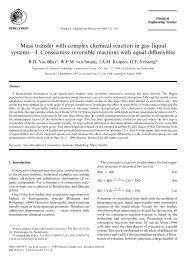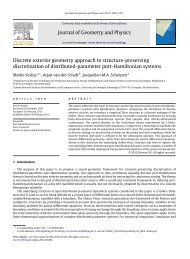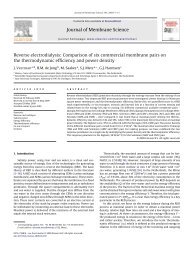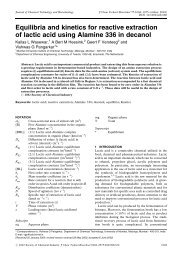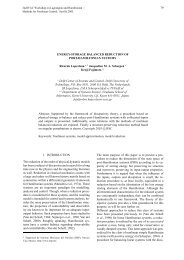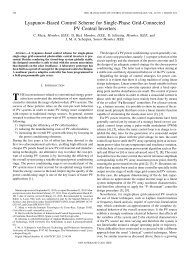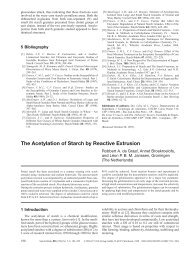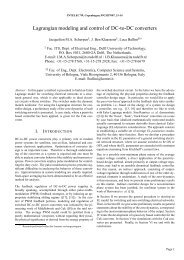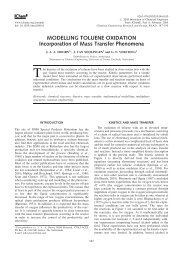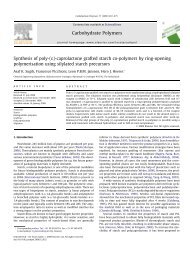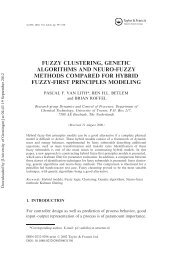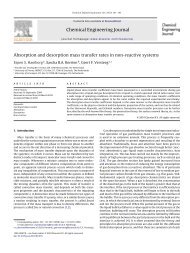Reverse electrodialysis: evaluation of suitable electrode systems - ITM
Reverse electrodialysis: evaluation of suitable electrode systems - ITM
Reverse electrodialysis: evaluation of suitable electrode systems - ITM
You also want an ePaper? Increase the reach of your titles
YUMPU automatically turns print PDFs into web optimized ePapers that Google loves.
1470 J Appl Electrochem (2010) 40:1461–1474A RED system should fulfill the requirements on safety,health, environment, technical feasibility and economics.In Table 3 the formulated criteria are applied to the differentdescribed <strong>electrode</strong> <strong>systems</strong> from Table 1 (for GS 1in bold, for GS 2 regular and for GS 3 in italics). The row‘reversal to the electrical current’ (A 1 ) is split up in threeparts for the combination <strong>of</strong> the different generating <strong>systems</strong>with the <strong>electrode</strong> system in question. The same goesfor the rows with the end-scores and ranks.Table 3 shows that from the described used <strong>systems</strong>(column 1–10), the iron system with Ti/Ru,Ir <strong>electrode</strong>s(column 8) is the best system in combination with each <strong>of</strong>the three generating <strong>systems</strong>.The hexacyan<strong>of</strong>errate system with the same <strong>electrode</strong>s(column 9) may be useful in laboratory equipment. Thetable also indicates that by application <strong>of</strong> graphite <strong>electrode</strong>sthe score <strong>of</strong> these <strong>systems</strong> is approached (column 11and 12).4.2 Proposal for improved <strong>electrode</strong> <strong>systems</strong>Possible improvements are:a Use <strong>of</strong> graphite <strong>electrode</strong>sAs indicated in Sects. 2.3 and 4.1, the use <strong>of</strong> graphite<strong>electrode</strong>s in combination with homogeneous redox systemlike Fe 2? /Fe 3? has good prospects.b Improved <strong>electrode</strong>s <strong>of</strong> the DSA type– Longer lifetimeFor their experiments Veerman et al. [1, 11, 15] usedtitanium mesh end <strong>electrode</strong>s, coated with Ru–Ir mixedmetal oxides. These <strong>electrode</strong>s are reversible (i.e. currentreversal is possible) and therefore usable for all types <strong>of</strong>stacks. Lifetime <strong>of</strong> these <strong>electrode</strong>s is more than 10 yearsunder the applied current density (4 mA cm -2 ). Animprovement <strong>of</strong> the lifetime with a factor 5 can beachieved with special Ir-MMO (mixed metal oxide) coatedtitanium anodes and Ru-MMO coated cathodes; anotheroption is to use the extra stability <strong>of</strong> these <strong>electrode</strong>s forreducing the cost <strong>of</strong> these <strong>electrode</strong>s by decreasing thesurface <strong>of</strong> the <strong>electrode</strong>s (the so called partial <strong>electrode</strong>s).A limitation <strong>of</strong> this system is that frequent current reversalduring longer times is not possible with these <strong>electrode</strong>s.– High overvoltages for Cl 2 /O 2 evolutionThe success <strong>of</strong> DSA type <strong>electrode</strong>s is due to a combination<strong>of</strong> high mechanical and electrochemical stabilitywith good catalytic properties and low overvoltages forspecial <strong>electrode</strong> reactions. Especially such anodes aredeveloped for Cl 2 and O 2 generation. However, in a REDprocess with a homogeneous redox couple (e.g. the Fe 2? /Fe 3? or the system [Fe(CN) 6 ] 4- /[Fe(CN) 6 ] 3- ), these reactionsare unwanted. Therefore, high overvoltages for gasevolution are favorable to the process. It requires someextra development to realize this with DSA type <strong>electrode</strong>s.– Specific composite <strong>electrode</strong>s for REDFor use in normal <strong>electrodialysis</strong> some <strong>systems</strong> withcomposite <strong>electrode</strong>s are patented [37–39]. These <strong>systems</strong>allow current reversal with <strong>electrode</strong>s which are specificallyusable as cathode or anode. In each current directiononly one part <strong>of</strong> each <strong>electrode</strong> is used. Eventually theunused part can be protected with a low potential differencebetween this part and the adjacent part in operation.c New homogeneous redox coupleHomogeneous redox <strong>systems</strong> (e.g. the system[Fe(CN) 6 ] 4- /[Fe(CN) 6 ] 3- ) do not cause net chemicalreactions and therefore the power losses are low. Mostorganic homogeneous redox couples involve protons intheir reactions and special measures should be taken tocontrol the pH. However, there are many iron complexesand possibly candidates are available that satisfy all mentionedcriteria. The use <strong>of</strong> graphite <strong>electrode</strong>s may beconsidered again in this case.d Capacitive <strong>electrode</strong>sThe last decades, special high ion absorbing carbon hasbeen developed for use in super capacitors [47–50] and incapacitive deionization (CDI) [51, 52]. If this material isused as <strong>electrode</strong> in a RED stack, during a certain time aninternal ionic current can persist. The <strong>electrode</strong>s behave asa capacitor and during that time there is also an externalelectrical current. After some time, the process should beinverted by changing the sea water and the river water feed.It is obvious that the changing time is related to the residencetime in the system. Assuming that time to be 1 min,then a half period (the time between two feed interchanges)should be at least about 60 min. Current RED stacksoperate at maximum power output with a current density <strong>of</strong>about 4 mA cm -2 or 144,000 C m -2 h -1 . The cathodeshould adsorb then 144,000/F = 1.5 mol Na ? and on theanode the same amount <strong>of</strong> Cl - (F is the Faraday constant;1 F = 96,485 C mol -1 ).Typical specific capacitances are reported <strong>of</strong> 100–200 F g -1 carbon in aqueous solution [47–50]. Using thehighest value <strong>of</strong> 200 F g -1 , for an uploading to 1 V, thereis 200 F g -1 carbon needed. For a 1-h operation, the<strong>electrode</strong>s should consist <strong>of</strong> 720 g carbon per m 2 .Thisseems a realistic value for further development <strong>of</strong> such asystem.In principle, the method is very clean and sustainable.Carbon aerogel <strong>electrode</strong>s may have lifetimes <strong>of</strong> more than10 years [53]. A restriction <strong>of</strong> this system is the obligatoryinterchange. For optimal performance, the connected loadshould be adapted continuously during one cycle. This ispossible with modern DC–DC converters. For normal<strong>electrodialysis</strong>, such a system is patented by Wei et al. [54].123



